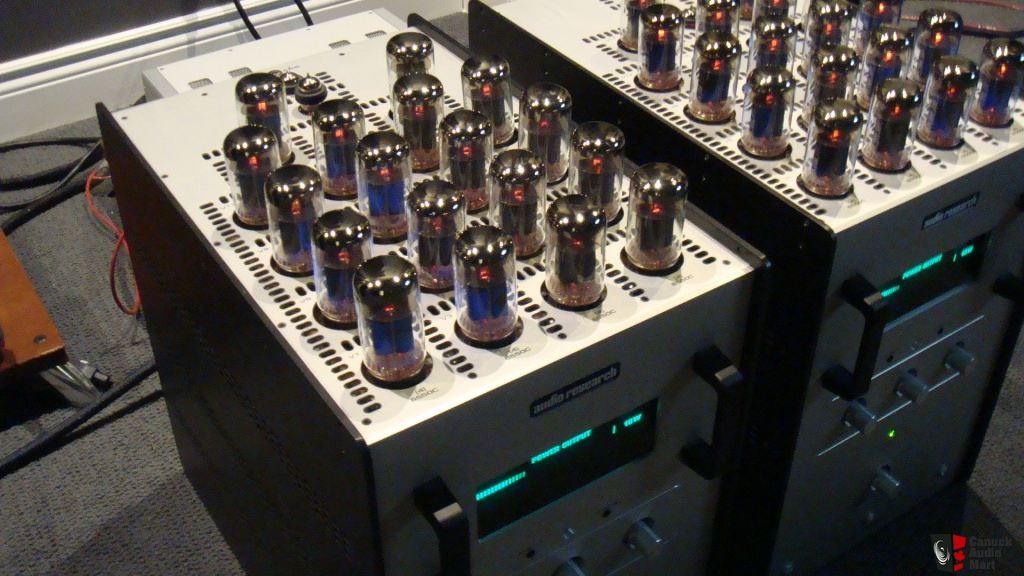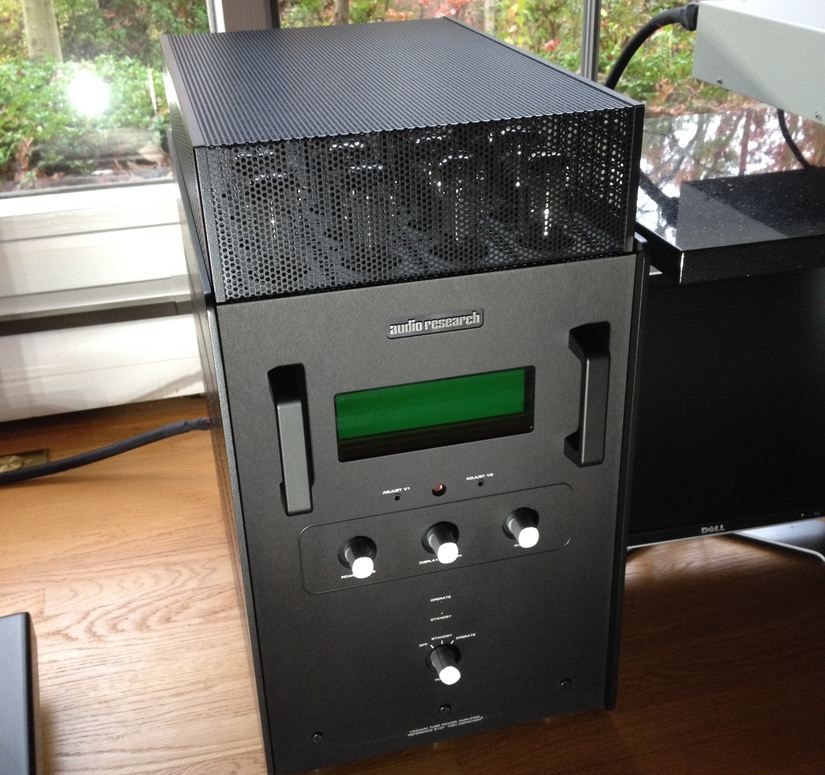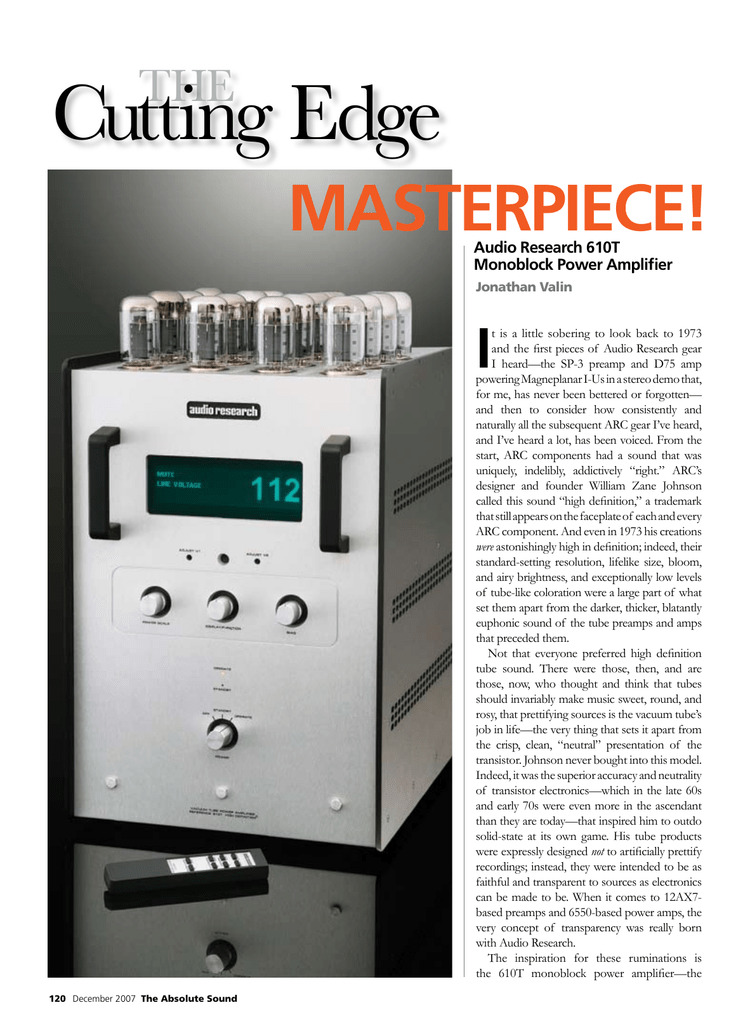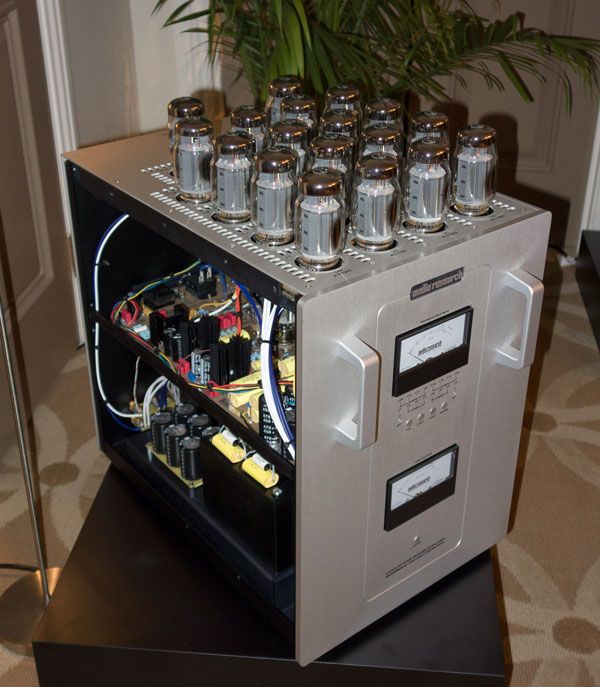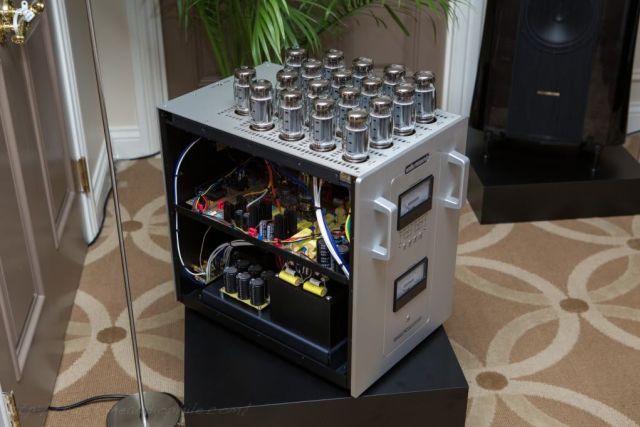Audio Research Reference 610t (NEW VALVES worth R160000)
Original price was: R660,000.00.R240,000.00Current price is: R240,000.00.
Audio Research Reference 610T Monoblock Amplifier
BRAND NEW unused KT120 valves
Just serviced, mint and boxed.
600W of pure valve power.
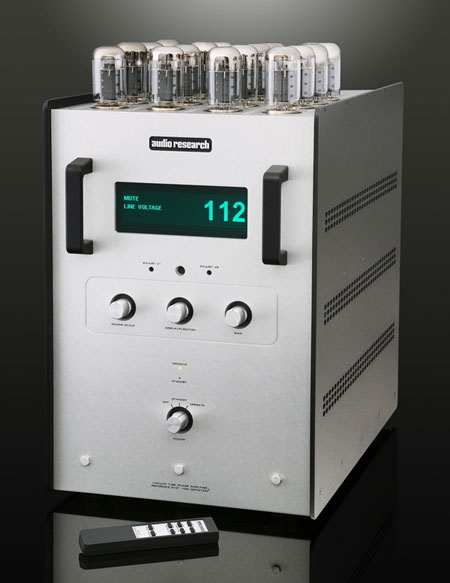 According to the company’s website, Audio Research is one of the oldest continuously operating manufacturers in American audio, having opened its doors in 1970. Among its many current products is the flagship Reference 610T monoblock power amp.
According to the company’s website, Audio Research is one of the oldest continuously operating manufacturers in American audio, having opened its doors in 1970. Among its many current products is the flagship Reference 610T monoblock power amp.
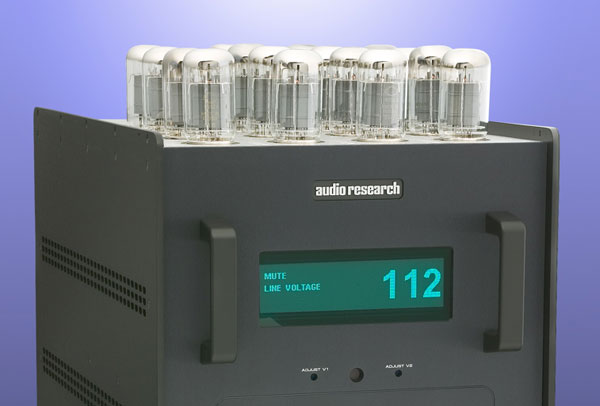
The 610T is a push-pull, fully balanced, tube-based design, with 16 6550C output tubes with two more 6550Cs serving as drivers, each controlling a bank of eight output tubes. Input gain is provided by two 6N1P dual triodes and a 6H30 follower, and all tubes are estimated to have a useful life of about 2000 hours.

This 170-pound bad boy can output gobs of power—600 watts continuous (20Hz-20kHz) into 4, 8, or 16Ω, with –3dB points at 15Hz and 150kHz. Of course, that much power requires even more power from the AC outlet—1700W at rated output, 2300W maximum—and it generates a lot of heat. The vertical-tower chassis employs silent convection cooling, though an optional fan is available for CE compliance.
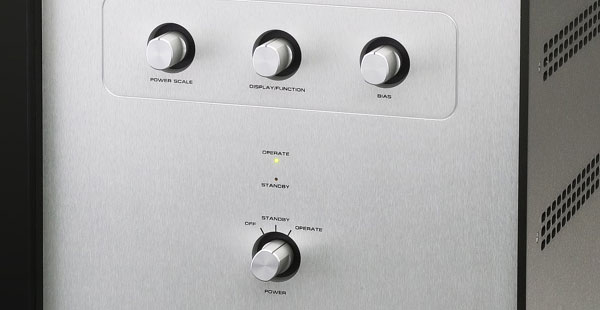
A vacuum-fluorescent, multifunction display can show the bias level on each tube, AC-line voltage, power output, and hours on the tubes. The amp is controlled with the front-panel controls or the included remote.
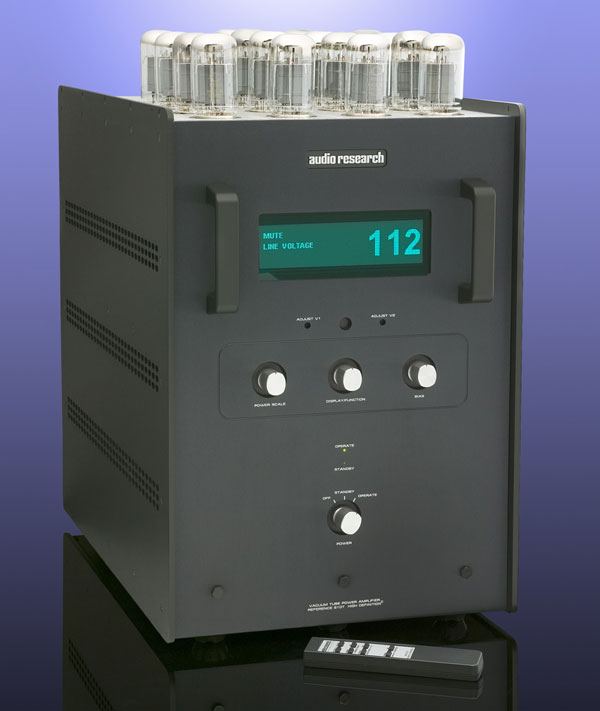
Naturally, a flagship product commands a flagship price—in this case, nearly $20,000 each. But just think about how all those glowing tubes will impress your audiophile friends!
It is a little sobering to look back to 1973 and the first pieces of Audio Research gear I heard—the SP-3 preamp and D75 amp powering Magneplanar I-Us in a stereo demo that, for me, has never been bettered or forgotten— and then to consider how consistently and naturally all the subsequent ARC gear I’ve heard, and I’ve heard a lot, has been voiced. From the start, ARC components had a sound that was uniquely, indelibly, addictively “right.” ARC’s designer and founder William Zane Johnson called this sound “high definition,” a trademark that still appears on the faceplate of each and every ARC component. And even in 1973 his creations were astonishingly high in definition; indeed, their standard-setting resolution, lifelike size, bloom, and airy brightness, and exceptionally low levels of tube-like coloration were a large part of what set them apart from the darker, thicker, blatantly euphonic sound of the tube preamps and amps that preceded them.
Not that everyone preferred high definition tube sound. There were those, then, and are those, now, who thought and think that tubes should invariably make music sweet, round, and rosy, that prettifying sources is the vacuum tube’s job in life—the very thing that sets it apart from the crisp, clean, “neutral” presentation of the transistor. Johnson never bought into this model. Indeed, it was the superior accuracy and neutrality of transistor electronics—which in the late 60s and early 70s were even more in the ascendant than they are today—that inspired him to outdo solid-state at its own game. His tube products were expressly designed not to artificially prettify recordings; instead, they were intended to be as faithful and transparent to sources as electronics can be made to be. When it comes to 12AX7- based preamps and 6550-based power amps, the very concept of transparency was really born with Audio Research.
The inspiration for these ruminations is the 610T monoblock power amplifier—the latest in ARC’s long, storied line of highpowered tube amplifiers and the subject of this review. Replacing the celebrated Ref 600 MkIII (much beloved by our EIC, Robert Harley) and capable of better than 600 watts into any load this side of a short circuit, it is the culmination of William Zane Johnson’s almost forty years of experience in amplifier design and constitutes both a continuation of and a significant advance beyond the virtues of previous ARC superamps.
The changes in the 610T begin with the way it looks. Designed and built on a vertical rather than a horizontal chassis, it is a tall, rectangular, 170-pound brushed-aluminum tower, which mounts its input and output tubes in the open on its top plate, without a surrounding cage. (In the dark all those lit-up 6550s glow like rows of candles on a tubelover’s birthday cake.) Concealed within the massive tower is a ground floor that houses output and power transformers, and a second story for power-storage-andregulation components. The tower design allows the 610T to rely on convection rather than built-in fans (with built-in fan noise) to cool its complement of twentythree tubes. That said, don’t count on convection to cool the 610T overly much. On a hot afternoon, the forty-six tubes in a pair of these amps can raise the ambient temperature of your listening room by a good 15–20 degrees in next to no time, making warm-weather listening necessarily a challenge (and necessarily brief).
Although the 610T, like virtually every Johnson power amp, uses 6550C pentode output tubes—sixteen of them in sets of eight matched pairs—in a fully balanced, push-pull, Class AB circuit, it also uses (for the first time) two 6550Cs as driver tubes—each controlling one bank of eight output tubes operated in unison. Twin 6N1P triodes and a 6H30 follower make up the input gain stage. The combination of the 6550 drivers and 6N1Ps/6H30 inputs has allowed for a welcome simplification of power-tube biasing; instead of having to adjust the 16 output tubes individually (as you did with the Ref 600 and previous ARC amps), in the 610T you need only bias the first two output tubes via set screws in the front of the chassis and the amp’s nifty vacuum-fluorescent display, which reads out bias measurements for each tube (as well as A.C. line-voltage levels, power output, and total hours of tube usage).
ARC says that power-supply energystorage has been increased substantially in the 610T to an astonishing 1000 joules, with substantial impact on sound quality (for which, see below). In a hybridizing move that Johnson has made successfully before in other products, ouput stage power-supply rectification and regulation is solid-state, while input gain stage regulation is both tube and solid-state. As usual with ARC, the 610T’s ultrawide- bandwidth output transformers are custom-made, with separate 4, 8, and 16- ohm output taps.2 Be aware that the 610T’s input is balanced only, so you’re going to need a preamp with balanced outputs. You’re also going to need dedicated 20- or 30-amp lines to feed a pair of 610Ts, each of which can draw as much as 2300 watts from your wall outlets (1700 at rated output).
Usually in ARC reviews I spend some time discussing how much closer Johnson has managed to inch his tubes toward solidstate territory, without giving up his claim on the tube’s own patch of sonic ground, and I will do so again here. But bear in mind that, while the 610T is greatly improved in neutrality, frequency extension, imaging, resolution, transient speed, power delivery, and transparency to sources, it is the way these new improvements seamlessly integrate with old strengths—like air, bloom, and soundstaging—that makes this amp so special. Indeed, it is the synergy of old and new that makes the 610T the current standard in high-powered tube amplification.
Let’s begin with tonal balance, as it is likely to be the first difference from past ARC amps that experienced listeners will notice. Whether it is the revised tube complement, the solid-state rectification and regulation of the power supply, the increased energy storage, or some concatenation of all three (plus circuit tweaks and changes I don’t know about), the 610T’s sounds less like “classic” ARC than any Audio Research amp I’ve previously owned or auditioned.
Though ARC amps have always been closer to neutral in balance than other tube and most solid-state amps, they have been neutral with a distinctive twist. Seemingly biased slightly toward the upper midrange and lower treble, they have tended to sound attractively bright, bloomy, present, airy, and clear. (If you think of the tonal balance of a great twoway loudspeaker—without a two-way’s roll-off in the bass—you’ll get the idea.) As I said in my review of the wonderful Focal-JMlab Electra 1007Be mini-monitor [Issue 176], I’ve always liked the little bit of added transient zip, low-level dynamic/ harmonic resolution, and lifelike air and brightness of the traditional ARC balance, because, to my ear it sounded more like real instruments in a lively hall. Nonetheless, that extra energy in the upper mids could make certain instruments—like flutes or piccolos or upper-octave strings—sound a touch brighter than life. With the 610T this has changed.
The new amp seemingly “re-biases” tonal balance to dead-center neutral, significantly extending this neutrality downward and upward without sacrificing the traditional ARC virtues of lifelike air and bloom in the upper octaves or, for that matter, in the midrange or bass. (Think of the 610T’s bass-to-treble balance as now being more like that of a great three-way loudspeaker, rather than a great two-way.) For ARC fans, the difference will be unmistakable and, at first, a little disorienting, in part because of the many other sonic differences than accompany it.
First, the hint of soft white grain that generally accompanied the uppermidrange/ lower-treble emphasis of ARC amps (a coloration I strongly associate with ARC electronics, in general) has been virtually eliminated. While recent ARC amps and preamps have already reduced this coloration considerably, the 610T banishes it almost completely.
Second, image focus has changed for the better. Compared to a Class A triode or solid-state amplifier, a pentode amp tends to make voices and instruments sound big and rather loosely focused. (To use the analogy to speakers again, pentodes in Class AB image like Magneplanars rather than like dynamic speakers.) As with ARC’s traditional tonal balance, I generally preferred these larger images to the razorcut miniatures of solid-state. Nonetheless, a happy medium needs to be struck, and the 610T strikes it. Though still life-sized, voices and instruments now have, dare I say it, higher definition. On a well-recorded LP, like the Skalkottas Sonatina No. 3 for Violin and Piano [EMI], the 610Ts make instruments that can be scaled to life size in an average listening room, such as Niklos Patrikidou’s violin, sound neither too big nor too small, neither too loosely focused nor too tightly focused, but just right. Ditto for voices, like Joan Baez’s sweet joyful soprano on “Gospel Ship” [Joan Baez in Concert, Part 1, Cisco/Vanguard]. I’ve always thought that lifelike image size was a greatly undersold virtue, as it not only tends to make performers and instruments more realistically present but also makes them sound less “hi-fi,” by drawing less attention to the speakers. The 610T is the most lifelike imager I’ve yet heard from ARC (or anyone else).
Third, maybe as a result of its improved imaging (and the overall lowering of colorations), the 610T is also the most finely detailed ARC amplifier I’ve heard, which is actually something of a surprise, since the first thing that generally gets traded off against very high power in an amp is lowlevel resolution. Not here. With a speaker capable of truly exceptional resolution and near-lifesized imaging—like the twoway MAGICO Mini II or the one-way Omega Max Hemp—the 610T can make an instrument like a clarinet not only sound like a clarinet, but look like one, too. The sonic cues that clue you in to the size, shape, material composition, and mechanical workings of an instrument are so plentiful here that it is almost as if a life-sized, largeformat photograph of the instrument is being projected between your speakers. I’m talking a “fool-you” facsimile of the real thing such as you generally only get with sound effects, like doorbells on DVDs. Here is an amp that can (given the right speaker and the right source) do this conjuring trick with select voices and musical instruments.
It won’t do this consistently, of course— most of the time you’ll have to settle for a superb approximation of the real thing rather than a facsimile—but the fact that it can do it at all is amazing.
Fourth, transient attack has also received a new jolt of speed, particularly in the midband. When I reported on how realistically the Kuzma and Walker turntables (with Air Tight PC-1 cartridge) reproduced the thunderous initial G minor chord of Andrej Gavrillov’s piano and the answering shrieks, plucks, and groans of Gidon Kremer’s violin that begin Schnittke’s witty dialogue between tonality and atonality, Quasi una sonata [EMI], I was also reporting on the 610T. Though a great solid-state amp like the MBL 9011 or the GamuT DI 150 still holds a transient-speed edge on the 610T, this is one very fast tube amp that can hold its own on everything from string pizzicatos to that lightning timp strike near the close of The Firebird. Moreover, the 610T maintains the tube’s superiority on stopping transients, reproducing decay and ambience as realistically as any amp I’ve heard.
Fifth, there is the unusually lifelike way that the 610T delivers power. It is a bromide to say that a tube amplifier clips “softly,” rounding off transient peaks when it runs short on steam rather than shearing them off the way a solid-state amp does (with subsequent audible distortion). However, it is one thing to clip softly; it is another not to clip at all. We are talking here about a monoblock amplifier that is capable of 630 watts of pentode power into any load. Unless you’ve heard a tube amp that is this seemingly unrestricted in power, you may have trouble understanding how smooth and unstrained—how non-hi-fi—the 610T sounds. Gone is not only any clipping distortion but the very sense of a dynamic ceiling hanging above the music. I think the best way to conceptualize this, at least for those of you who know your recordings, is to think of an album in which dynamic limiting has been deliberately applied— such as an old RCA Dynagroove—and then think of an album in which no limiting has been used—like a Sheffield direct-todisc. The 610T consistently sounds like the Sheffield, and makes most other amps sound like the Dynagroove.
Getting rid of any of the usual chokes on power delivery has a wonderful liberating effect on music of every kind. It is not that music will play “louder” with the ARC 610T, although it will; it is the way it gets loud that is so uncannily lifelike.
Take a tenor voice, such as Mario Lanza’s on “Il lamento di Federico” from Cilea’s L’Arlesiana (Mario Lanza Live in London [RCA]) for example. Part of the reason why a tenor voice is no snap for an amplifier to reproduce (and why it can cut through dense instrumental textures and seemingly soar ahead of and above an entire orchestra) is the tremendous amount of acoustical power it has in the 2–3kHz range (the “formant” range for higher-pitched male singing voices), for which see the chart to the right, reprinted from the late John Eargle’s superb text Music, Sound, and Technology (Van Nostrand Reinhold, 1995].
A powerful tenor can reach astonishing dynamic peaks on fortissimos. Indeed, this Lanza recording has undone many an amplifier at CES and in my home. At lifelike levels, during the searing climax of the Cilea aria, most amps simply hit the wall—making Lanza’s gorgeous voice sound progressively rougher, shriller, flatter, “beamier,” as he nears the crescendo’s peak, before shattering at the peak itself as if from mike overload.
Rather than roughening and flattening Lanza’s voice during the crescendo of this aria and then clipping at its climax, the Audio Research 610T has the power reserves and the natural delivery to project it, making it sound bigger rather than beamier, fuller rather than flatter, stronger rather than shriller, more forward rather than more recessed as he builds to the crescendo and then to simply sail through the peaks without any loss of composure or impact. I’ve called this ability to realistically reproduce the way imaging changes with changes in dynamics “action” or bloom, and the 610T simply handles vocal and instrumental action better than any amplifier I’ve yet heard (and, in so doing, makes instrumental dynamics more lifelike than any other amplifier I’ve yet heard).
Finally, soundstaging, always an ARC strength, is here taken to a new level. On a great orchestral recording like Lutoslawski conducting the Nationales Symphonie- Orchester des Polnishcen Rundfunks in a bracing performance of his own Concerto for Orchestra [EMI]—one of the truly great pieces of music of the second half of the twentieth century—the 610T fills the back third of my room with a virtual orchestra, Lanza’s voice as he himself was projecting wall-to-wall, wall-to-floor, floor-to-ceiling. Even on smaller-scale music, like Joan Baez and the Greenbriar Boys singing “Banks of the Ohio” [Joan Baez, Vol. 2, Vanguard], the 610T will fill the space between speakers and boundaries with near-life-sized images of Joanie, her backup singers, their instruments, and the ambience of the recording venue. (There are reasons why manufacturers of big speakers, like Dave Wilson, often prefer the 610T—they will drive any speaker and fill any space, no matter how small or large, with music.)
I started off by saying that it wasn’t the individual virtues of the 610T but their synergy that makes the amp so special, because what all of these things add up to— the improvements in neutrality, coloration, imaging, resolution, transient response, power delivery, action, and staging—are a huge improvement in transparency to the source. By this I mean that the 610T imposes less of its own signature on whatever LP or CD it is playing, and in reducing its own signature reduces our sense of listening to and through an electromechanical chain of hardware. I’ve always felt that the first obligation of any piece of stereo equipment is to disappear as a sound source. The 610T does this to an extent I’ve never before experienced with an amplifier. For the most part, it simply lets you forget you’re listening to a hi-fi.
Oh, there are still a few areas where the 610T reminds you that it’s there. For one, it is consistently a little forward sounding, starting its imaging nearer to the plane of the speakers, rather than deep behind them. For another, as good as the 610T is in the treble, you cannot listen to it in comparison to a great solid-state amp like, say, the GamuT DI 150, and honestly say that it has all of the top-octave speed, focus, and detail that make something like the piano on the truly superb Decca Headline recording Mr. John Cage’s Prepared Piano so uncannily like a virtual choir of cymbals, bells, and drums. Through the 610T, all these sounds will be somewhat more relaxed, more gemütlich. (Paradoxically, this isn’t as true of the low bass, where the ARC will reproduce ostinatos like the deep cello and doublebass pizzicatos at the start of the Passacaglia of the aforementioned Lutoslawski Concerto for Orchestra with precise pitch definition and astonishingly realistic air and speed.)


